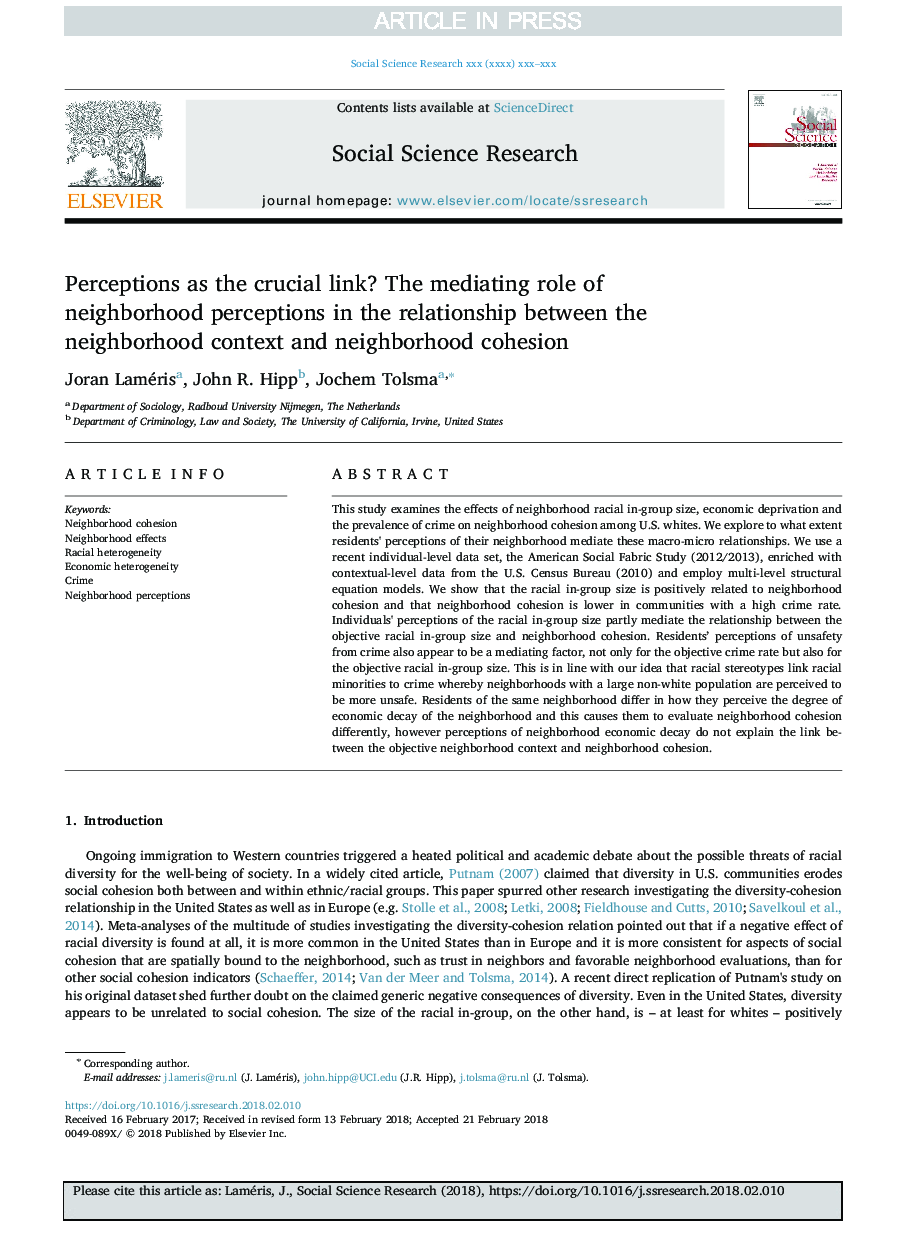| کد مقاله | کد نشریه | سال انتشار | مقاله انگلیسی | نسخه تمام متن |
|---|---|---|---|---|
| 7338599 | 1476103 | 2018 | 16 صفحه PDF | دانلود رایگان |
عنوان انگلیسی مقاله ISI
Perceptions as the crucial link? The mediating role of neighborhood perceptions in the relationship between the neighborhood context and neighborhood cohesion
ترجمه فارسی عنوان
درک به عنوان پیوند حیاتی نقش میانجی از ادراکات محله در رابطه بین محله و انسجام محله
دانلود مقاله + سفارش ترجمه
دانلود مقاله ISI انگلیسی
رایگان برای ایرانیان
کلمات کلیدی
انسجام محله اثرات محله، ناهمگونی نژادی، ناهمگونی اقتصادی، جرم، ادراکات محله،
ترجمه چکیده
این مطالعه به بررسی اثرات محدوده نژادی درون گروهی، محرومیت اقتصادی و شیوع جرم در همسویی محله در میان سفیدپوستان ایالات متحده است. ما بررسی می کنیم که تا چه حد درک شهروندان از محله هایشان این روابط کوچک و کوچک را به نفع خود می اندازند. ما از یک مجموعه داده های اخیر در سطح فردی، مطالعات اجتماعی آمریکایی (2012/2013)، با داده های محتوا از اداره آمار ایالات متحده (2010) غنی شده و از مدل های معادلات ساختاری چند سطحی استفاده می کنیم. ما نشان می دهیم که اندازه گروه نژادی در رابطه با انسجام همجواری مثبت است و همبستگی محله در جوامع با نرخ جرمی بالا پایین است. ادراک افراد نسبت به اندازه نژادی در گروهی تا حدودی میان رابطه میان اندازه نژادی درون گروهی و انسجام محله موثر است. ادراک ساکنان ناامن از جرم نیز به عنوان عامل واسطه نه تنها برای میزان جرم و جنایت عینی بلکه برای اندازه نژادی درون گروهی نیز ظاهر می شود. این در راستای ایده ماست که کلیشه های نژادی از اقلیت های نژادی به جنایت پیوند می دهند، به این ترتیب محله هایی با جمعیت غیر سفید سفید، بیشتر در معرض خطر هستند. ساکنین همسایگی مشابه در این است که چگونه میزان فساد اقتصادی محله را درک می کنند و این باعث می شود که آنها همسایگی محله را متفاوت ارزیابی کنند، با این حال ادراکات فرسایش اقتصادی محله ارتباط بین محله محله ی هدف و همسایگی محله را توضیح نمی دهد.
موضوعات مرتبط
علوم انسانی و اجتماعی
روانشناسی
روانشناسی اجتماعی
چکیده انگلیسی
This study examines the effects of neighborhood racial in-group size, economic deprivation and the prevalence of crime on neighborhood cohesion among U.S. whites. We explore to what extent residents' perceptions of their neighborhood mediate these macro-micro relationships. We use a recent individual-level data set, the American Social Fabric Study (2012/2013), enriched with contextual-level data from the U.S. Census Bureau (2010) and employ multi-level structural equation models. We show that the racial in-group size is positively related to neighborhood cohesion and that neighborhood cohesion is lower in communities with a high crime rate. Individuals' perceptions of the racial in-group size partly mediate the relationship between the objective racial in-group size and neighborhood cohesion. Residents' perceptions of unsafety from crime also appear to be a mediating factor, not only for the objective crime rate but also for the objective racial in-group size. This is in line with our idea that racial stereotypes link racial minorities to crime whereby neighborhoods with a large non-white population are perceived to be more unsafe. Residents of the same neighborhood differ in how they perceive the degree of economic decay of the neighborhood and this causes them to evaluate neighborhood cohesion differently, however perceptions of neighborhood economic decay do not explain the link between the objective neighborhood context and neighborhood cohesion.
ناشر
Database: Elsevier - ScienceDirect (ساینس دایرکت)
Journal: Social Science Research - Volume 72, May 2018, Pages 53-68
Journal: Social Science Research - Volume 72, May 2018, Pages 53-68
نویسندگان
Joran Laméris, John R. Hipp, Jochem Tolsma,
